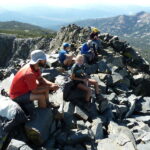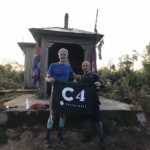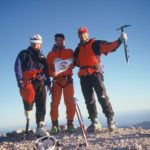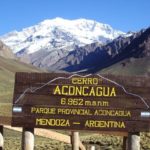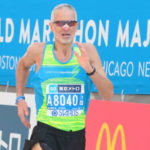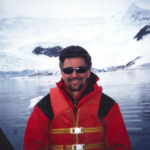

TRIP REPORT #7 – The Sands of Namibia
In the summer of 2015, my wife Deb and I were planning our next adventure. I was looking for a new country, an interesting high point, and a trip that would be outdoors-oriented. Deb was interested in wildlife viewing, and she suggested we find somewhere in Africa. We decided a trip to Namibia would tick all the boxes.

In June, we flew to Windhoek and rented a car. For the most part, Namibia’s road system is very good, and I was looking forward to driving all over the country. We headed to Sossusvlei, a part of Namibia that has huge, beautiful sand dunes bordering something called the Dead Vlei, where the skeletons of dead trees are scattered on a pan of dried mud.

We stayed at Sossus Dune Lodge, in the park. After checking in, we went out and climbed one of the sand dunes, Dune 45, before having dinner and going to bed. We got up early the next morning and headed to the trailhead to hike in to “Big Daddy,” the tallest dune in the area, which is adjacent to the Dead Vlei. We started hiking in the dark, and were on top of the dune before the sunrise. When the sun came up, the view was spectacular. Then we ran down the back side of the dune, skating and sinking through the sand, right into the Dead Vlei. Walking through the dead trees in the pan was surreal, like being on another planet, with the red dunes rising up on all sides. We were there so early that we had the whole pan to ourselves for a little while, just sharing it with a couple of indigenous oryx called gemsbok, before the other tourists appeared.


We headed north, to the coast to Swakopmund. On the way, we stopped for gas and the best apple pie that I’ve ever had, in Solitaire.

In Swakopmund, we explored the coast with a guy who drove us over the sand in a Land Rover, and took us to a place where we climbed a nearly vertical dune overlooking the ocean. He drove the vehicle up the other (more gentle) side of the dune and we picnicked on top of the dune, with the best lunch view in the country. On the drive down, we bounced and slid through the sand.



The next day, we went on a three-hour flight in a six-seater plane (two pilots and four passengers) over the dunes and along the famous Skeleton Coast. From the air, we could see all the different colors in the dunes—red, yellow, gold and white—and thousands of cape fur seals lying on the beach. We flew over the remains of old diamond mines, which were almost buried in the sand, as well as two shipwrecks. Over time, the shipwrecks had started slowly moving inland, as the sand from the dunes is gradually expanding the shoreline out into the ocean. It was a beautiful, breathtaking experience unlike anything we’d ever seen.



After the aerial tour, we continued north to Uis. Our destination was the Brandberg Rest Camp, owned and managed by a man named Basil Calitz. I had talked with Basil online prior to our arrival, and he had taken care of all of the paperwork to arrange my climbing permit through the National Parks service for the Brandberg (Burnt Mountain), the high point of Namibia. The Brandberg’s highest peak is Konigstein, at 8550 feet. Typically people spend three days and two nights in order to summit Konigstein. They hike to a camp, spend the night, summit the mountain the second day, and return to spend the second night at the same camp. They descend on the third day.
Naturally, I was not interested in spending three whole vacation days climbing a 8550-foot peak that required no technical skills.
So in corresponding with Basil, I had asked him if I could go up and down in a day. He was a little skeptical, but said he would set me up with the fittest guide he could find, who would be best suited to round-trip it in a single day. (I tried to convince him that I could do the climb without a guide, but because of the National Park rules, that was not going to happen!)
After we checked in at the Rest Camp and met Basil, we drove to the park office to pick up my permit. While we were there we hiked into the park to see “The White Lady of Brandberg,” a famous rock painting.




The next morning, we had breakfast with Basil. My guide, John Taniseh, met up with us at the hotel. After breakfast, Basil, Deb, John and I drove to the trailhead. John and I started our climb. While John and I climbed, Basil and Deb drove all over the area, looking at geological sites and watching for wildlife, having a picnic lunch outside with zebras looking on.


The climb was straightforward, and relatively easy. The trail was well marked, and it was a beautiful day. John initially seemed skeptical about the single-day expedition, but I let him set the pace, and we were on the summit in about 4 hours. We spent about half an hour on top, and then headed back down. When we arrived at the trailhead, Deb and Basil were waiting for us. They’d set up an outdoor barbecue, called a braai; they were already grilling steaks and had cold beers ready for us! Basil shook my hand, and congratulated me. Unbeknownst to me, he had started his watch when we began our ascent, and he told me that he clocked us at 8 hours and 6 minutes round-trip. He informed me that this was a new record. I thought to myself that if I’d known I was trying to establish a record, I wouldn’t have hung out for half an hour eating lunch and taking pictures, and I would have run the downhills!


That night at dinner, Basil presented me with a framed photo of John and me with the date, and our record-setting time printed on it. He hung a copy in the hotel bar, and he had one made for John, too. That picture hangs in my office now. It was such a thoughtful gesture, and I could tell that he was really proud to have been a part of our expedition.

Our next destination was Etosha National Park, further north. We stayed at Okaukuejo Rest Camp, in the park. This allowed us to sit outside at the watering holes after dark, which was an incredible opportunity to see wildlife. One night we saw three rhinos and seven elephants at once, all sharing the watering hole with zebras, antelopes, and giraffes. During the day, we drove through the park, stopping at watering holes or just pulling over to the side of the road, watching lions, rhinos, giraffes, warthogs, elephants, ostriches, cape buffalo, wildebeest, hartebeest, impala, springbok and gemsbok. My favorite thing about Etosha compared to other African wildlife parks that I have visited, was that we had complete autonomy; we could drive ourselves everywhere. The only rule was “Don’t get out of your car!” It’s a good rule, and we were happy to follow it!





When we left Etosha, we headed back to Windhoek. While I was checking in at the hotel, Deb was walking around the lobby and started flipping through the newspapers, many of which were in Afrikaans. Behind my back, I heard her start laughing, and she said, “Hey, Fred…”.
On the front page of a Namibian newspaper called the “Republikein” was a picture (taken by Basil) of John and me! The article was in Afrikaans, and was titled “Amerikaner Klim Brandberg in Rekordtyd” (American Climbs Brandberg in Record Time). We showed the picture to the guy at the hotel’s front desk, and he was pretty impressed. He shook my hand, read us the article (translating it into English), and let us keep the paper!

Later that day when we went into town to eat and do a little souvenir shopping, we were in a grocery store, and we saw a rack of the “Republikeins”. The next day in the airport, 2 different men came up to me, and asked me if I was the American from the paper. They shook my hand, and congratulated me. I felt like climbing royalty. That newspaper front-page is one of my all-time favorite souvenirs!

